Full coverage: China 2012-2015 Human Rights Progress Review
II. Economic, Social and Cultural Rights
From 2012 to 2015, China continued to deepen reform and adopted a series of important measures to promote development and improve people's livelihoods, comprehensively strengthening the guarantee of people's economic, social and cultural rights. Major targets set by the Action Plan were fulfilled on schedule.
(1) Right to work
Figure 1: New urban jobs 2012-2015 (Unit: Ten thousand)
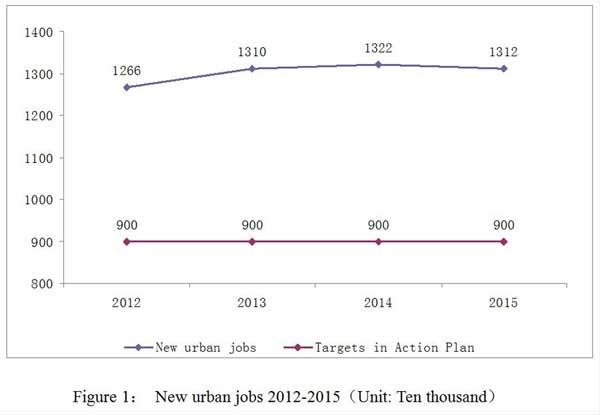
BEIJING, June 14, 2016 (Xinhua) -- Graphics shows new urban jobs 2012-2015 in the Assessment Report on the Implementation of the National Human Rights Action Plan of China (2012-2015). (Xinhua)
Equal rights to employment have been guaranteed. In 2012, 2013, 2014 and 2015, 12.66 million, 13.1 million, 13.22 million and 13.12 million new urban jobs were created respectively, surpassing the target of 9 million new jobs every year. The registered urban unemployment rate was kept within 4.1 percent, lower than the 5 percent target.
Figure 2: Number of regions that increased minimum wages and average rate of increase (2012-2015)
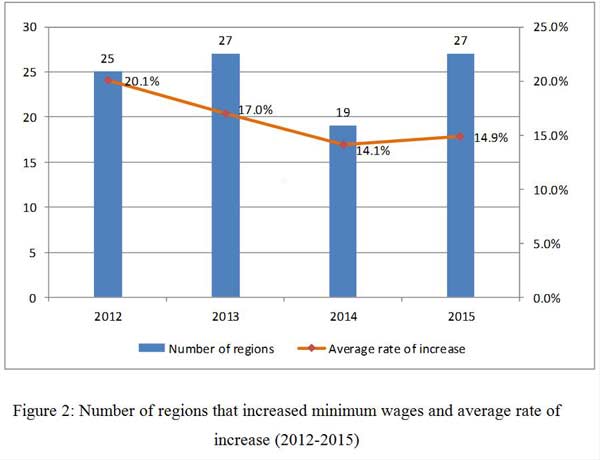
BEIJING, June 14, 2016 (Xinhua) -- Graphics shows number of regions that increased minimum wages and average rate of increase (2012-2015) in the Assessment Report on the Implementation of the National Human Rights Action Plan of China (2012-2015). (Xinhua)
The right to get work remuneration as well as rest and leave has been further guaranteed. In 2012, 2013, 2014 and 2015, minimum wages were raised in 25, 27, 19 and 27 regions respectively by 20.1 percent, 17 percent, 14.1 percent and 14.9 percent. In 2012, the Standing Committee of the National People' s Congress amended the Labor Contract Law, again stressing equal pay for equal work. In 2015, more than 90 percent of employees working in various enterprises signed labor contracts. More than 50 percent of workers enjoyed annual leave with pay in 2015, according to a survey on human resources and social security conducted in 60 cities in November 2015.
Work safety conditions have continued to improve. The State Administration of Work Safety issued Opinions on Further Enhancing the Construction of the System of National Work Safety Emergency Platforms. The central government, 20 provinces (autonomous regions and municipalities directly under the central government), some cities, major counties and large enterprises in high-risk industries set up separate work safety platforms. Communication and connectivity were established among the platforms of the central government, 13 provincial regions and 7 national mine emergency rescue teams. Compared with 2011, the number of all types of industrial accidents and the number of deaths decreased by 19 percent and 12.4 percent respectively and the number of major industrial accidents and the number of deaths decreased by 47.2 percent and 31 percent respectively. In 2013, the Standing Committee of the National People's Congress deliberated and passed the Law on Special Equipment Safety. From 2011 to 2015, while the total number of special equipment increased by 70 percent, the number of deaths related to special equipment was kept within 300 each year for five consecutive years and the death rate for every 10,000 pieces of special equipment decreased to 0.36 in 2015 from 0.67 in 2010, matching the level of special equipment safety in medium developed countries. Relevant government departments revised the Administrative Measures for Diagnosis and Identification of Occupational Diseases and the Classified List of Hazardous Factors of Occupational Diseases, formulated five regulations including the Provisions on the Supervision and Administration of Occupational Health at Work Sites, the Measures for the Administration of Occupational Health Examination and criteria for diagnosing new occupational diseases. They also issued over 70 occupational health technical standards including the Technical Code for Dust Control in Stone Material Processing. Special campaigns were launched to control dust and hazardous materials in industries prone to occupational diseases including gold mining, cement production, stone material processing and wood furniture making.
The skills of workers have been upgraded. Rural and urban workers received extensive vocational training. By the end of 2015, the total number of skilled workers had reached 167 million, exceeding the planned target of 125 million ahead of schedule. 45.01 million of them were highly-skilled workers, accounting for 27.28 percent of the total.
(2) Right to basic living standards
Figure 3: Percentage of increase of GDP, urban residents' per capita disposable income and rural residents' per capita net income (2012-2015)
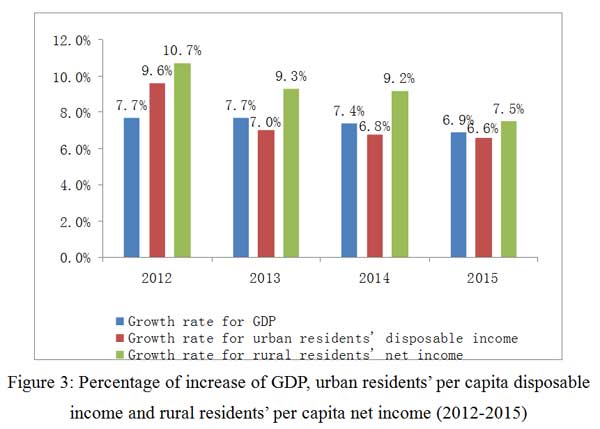
BEIJING, June 14, 2016 (Xinhua) -- Graphics shows percentage of increase of GDP, urban residents' per capita disposable income and rural residents' per capita net income (2012-2015) in the Assessment Report on the Implementation of the National Human Rights Action Plan of China (2012-2015). (Xinhua)
From 2012 to 2015, the increase of residents' per capita disposable income surpassed the growth rate of GDP of the same period. The annual growth rate of the per-capita disposal income of urban residents and per-capita net income of rural residents were 7.5 percent and 9.2 percent respectively, exceeding the planned target growth of 7 percent.
Tangible results have been achieved in poverty reduction. In 2012, relevant government departments formulated the 12th Five-year Plan for Poverty Reduction Village By Village. By 2015, poverty alleviation projects covering 30,000 villages had been implemented, exceeding the target of 24,000 villages. Investment totaled 144.569 billion yuan, an average of 4.8 million yuan for each village. From 2012 to 2015, the State Development and Reform Commission appropriated 21 billion yuan from the central budget for relocation of impoverished residents, which brought about an additional more than 200 billion yuan in local government input and various other investments. About 8 million people in poverty were relocated. Training programs in practical skills focusing on planting and breeding were conducted for 9.3 million impoverished laborers who chose to stay. The government allocated various poverty reduction funds totaling 25.53 billion yuan for 17 impoverished border counties (cities) and launched 3,807 poverty reduction projects in border areas, directly benefiting 306,000 households. By the end of 2015, over 729,000 technicians had been sent to grassroots levels in rural areas, covering 90 percent of all counties (cities, districts) and helping 60 million people directly or indirectly.
Figure 4: Rural population in poverty 2012-2015(Unit: ten thousand)
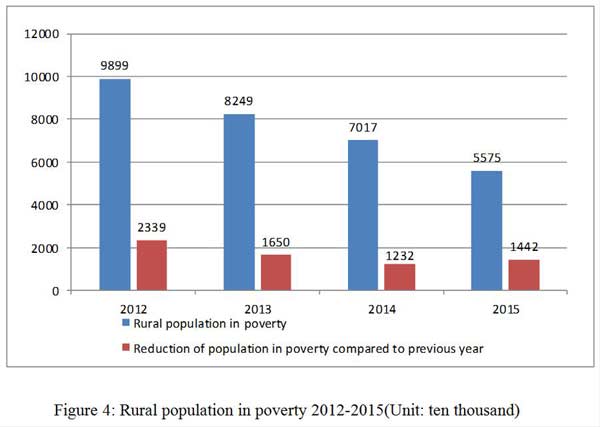
BEIJING, June 14, 2016 (Xinhua) -- Graphics shows percentage of increase of GDP, urban residents' per capita disposable income and rural residents' per capita net income (2012-2015) in the Assessment Report on the Implementation of the National Human Rights Action Plan of China (2012-2015). (Xinhua)
The number of people living in poverty has been greatly reduced. From 2012 to 2015, the number of people living in poverty in rural areas was reduced by 66.63 million. In 2015, the state raised the national poverty alleviation standard from the 2010 level of 2,300 yuan to 2,855 yuan following a dynamic adjustment mechanism. The standards set by some provincial regions were higher than the national standard.
Figure 5: Number of housing units starting construction in various dilapidated areas 2012-2015 (Unit: ten thousand units)
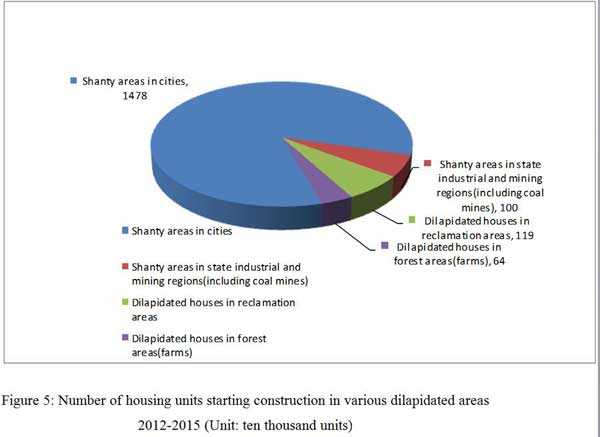
BEIJING, June 14, 2016 (Xinhua) -- Graphics shows number of housing units starting construction in various dilapidated areas 2012-2015 in the Assessment Report on the Implementation of the National Human Rights Action Plan of China (2012-2015). (Xinhua)
Housing conditions have been improved. In 2012, the Ministry of Housing and Urban-Rural Development issued the Measures for the Administration of Public Rental Housing. In 2014, the public rental housing system and the low-cost rental housing system merged into one. From 2012 to 2015, the state allocated 770 billion yuan to support affordable housing projects, with 29.7 million housing units starting construction and with 24.28 million units basically completed. The central government provided a subsidy of 127.1 billion yuan for redevelopment of dilapidated buildings in rural areas nationwide, with 15.24 million housing units redeveloped, exceeding the planned target by more than 200 percent.















